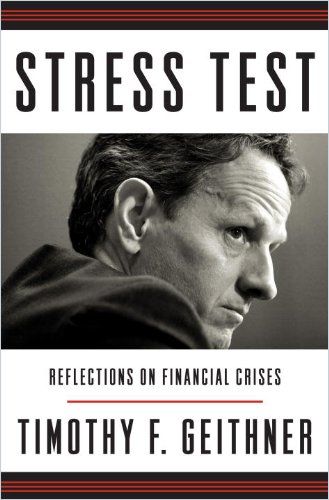A former secretary of the Treasury provides candid details of every decision during and after the 2008 financial crisis.

No Safe Path
In this New York Times, Los Angeles Times and Washington Post bestseller, Timothy F. Geithner – former president of the Federal Reserve Bank of New York and former secretary of the Treasury under President Barack Obama – details his crucial role in the 2008 financial crisis and its aftermath. Geithner reveals the brutal decisions and unpopular compromises that the crisis demanded with a frankness unusual for someone in US public service and with a minimum – though not a total absence – of self-justification.
The Economist called this “a how-to manual for anyone faced with a financial crisis…Mr. Geithner was known for his brutal candor, and as an author, he does not disappoint.” Time found this “an unsparing insider’s account of the financial crisis…unpacking the hard decisions and terrible trade-offs that devastated the economy but staved off a deep, lasting depression.”
A Centrist Career
Geithner tells of attending Dartmouth College and Johns Hopkins University, and of studying in China. He worked as an undersecretary to President Bill Clinton’s Treasury secretaries, Robert Rubin and Lawrence Summers, and then he joined the IMF. When the global economy crashed in 2008, Geithner was leading the New York Fed, which raises the question: Why didn’t he see the crisis coming?
Every financial crisis is a crisis of confidence…Confidence is a fragile thing. When it evaporates, it usually evaporates quickly. And it’s hard to get back once it’s lost.Timothy Geithner
Geithner then became Treasury secretary under Obama, facing the thankless task of bailing out Wall Street in 2009. Bankers and Republicans bashed the rescue Geithner orchestrated as punitive and intrusive, while progressives, the author notes, panned it as insufficiently punitive and intrusive.
AIG Bonuses
In one telling behind-the-scenes detail, Geithner recounts his incensed response to news reports that bailed-out insurance giant AIG had granted lucrative bonuses to its executives. Despite that brief moment of passion, it’s clear that emotion is not Geithner’s habitat; he describes making decisions according to logic or on calculations about how voters, investors and Congress might have reacted to his every utterance.
“Stress Test”
Geithner describes the stress test of the title as his signature innovation at Treasury. Progressives wanted to nationalize the banks, and conservatives thought a few banks should fail. Geithner opted for a middle way: Federal examiners dove into banks’ books to discover whether the banks could survive further financial calamity. If regulators found things were dire, the government made up the cash shortfalls.
Missteps
Geithner insists throughout this long book that he and Obama chose the correct path. But he isn’t afraid to admit his missteps. For example, he acknowledges he ruined his first speech as Treasury secretary with his clumsy presentation, which one Wall Street economist described as “shock and ugh.”
We lived through months of terror. We endured seemingly endless stretches when global finance was on the edge of collapse, when we had to make monumental decisions in a fog of uncertainty, when our options all looked dismal but we still had to choose.Timothy Geithner
Geithner also cops to the lax regulation of megabanks such as Citi when he was a central banker. He acknowledges that former Treasury secretary Robert Rubin’s presence at Citi made Geithner less skeptical than he should have been. In the realm of political memoir, such a mea culpa qualifies as shocking candor.
Outsider
Despite his Ivy League pedigree, Geithner positions himself as an outsider in New York and Washington’s halls of power. As he learned the ropes, Geithner relates, he remained a technocrat and a practical centrist. Geithner explains that he believed in the Keynesian model of fiscal stimulus in a downturn. Conservatives blanched at throwing billions of dollars at recovery, but Geithner writes that the bigger mistake would have been too little stimulus spending.
Misunderstanding
Geithner describes the crisis as a perpetual tightrope with moments of bitter levity. He presents JPMorgan Chase’s Jamie Dimon as sincerely perplexed that neither Geithner nor Obama wanted him to help whip up new regulations. Dimon, Geithner writes, seemed blind to the optics of those who caused the crisis writing new rules after it.
Geithner maintains that Obama did not want to be a populist. During the crisis, seeking to appease a public howling for Wall Street blood, Geithner describes asking former President Clinton’s advice. Clinton, showing his tough-minded realpolitik, told him to push for higher tax rates on the wealthy but seemed unhappy about it.
Geithner argues – somewhat unconvincingly – that identifying and punishing individual villains would have only worsened the US financial situation. He did not want to watch large employers collapse or let the government pick which creditors should walk away with less than they were owed. Thus, Geithner claims, he chose the unpleasant task of propping up reckless financial institutions with US taxpayers’ money.
Cold-Blooded Choices
Geithner depicts himself as having no choice but to follow the paths he forged. He perhaps accurately describes himself as then the most brutally second-guessed man in America. Geithner invites readers inside the arcane world of finance with almost too much detail, but his determination to explicate every step of every decision is admirable, though you may crave less information about every Oval Office argument or struggle with Wall Street titans. Yet regardless of where you stand on the political or financial continuum, you will not find a more inside telling of the beginning, middle and aftermath of the financial crisis. Geithner provides a brave, invaluable history for those too young to have lived through it and for those who never want to live through it again.
Geithner has co-written other books about dealing with the 2008 financial crisis, including Firefighting and First Responders. Other worthy explorations of the crisis include The Big Short by Michael Lewis, Too Big To Fail by Andrew Ross Sorkin and After The Music Stopped by Alan S. Blinder.













